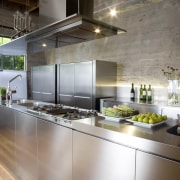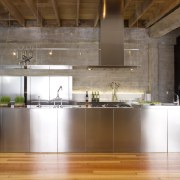Everything old is new
Raw concrete walls, steel windows and exposed wood beams form a magical backdrop to the polished stainless steel elements of this new kitchen in a refurbished 1940s warehouse

Recycling and sustainability are design priorities for many homeowners and designers today, but probably not on the scale of this project.
For her own home and business premises, designer Larissa Sand chose to refurbish a dilapidated, three-story 1940s warehouse that had been due for demolition.
"Original materials were salvaged wherever possible," Sand says. "For example, the concrete and timber elements were scraped, sandblasted and sealed, and the steel sash windows refurbished. We also opened up the interior to create a large, industrial-style backdrop for contemporary furniture pieces."
A new polished stainless steel Boffi kitchen was inserted into the space the sleek steel cabinets forming a startling contrast to the raw, weathered concrete walls and exposed timber beams.

"The kitchen has a very minimalist, architectural look that offsets the rough, rustic surfaces, yet the stainless steel is in harmony with the industrial nature of the building," says Sand.
To enhance the contrast, the concrete walls and rafters are lit with fluorescent uplights. Other lighting is provided within a floating ceiling that runs right through the center of the building. Task lighting above the island in the kitchen is set into a suspended steel hood, which also supports the ventilation unit.
Sand says that despite its clean-lined simplicity, the kitchen is highly functional. Two stainless steel cabinets at the rear accommodate pull-out pantries, and storage is also provided in the island.
With plenty of countertop space and two sinks, there is also space for more than one person to work in the kitchen at the same time. One end of the island features an asymmetrical elevated steel platform that provides a raised food preparation area. The platform appears to fold down the end of the island, creating a distinctive design element.

The oven and refrigerator are positioned at one end of the kitchen, within a wall of blackened, hot-rolled steel that has been waxed.
"Visually, the black steel bridges the gap between the sleek stainless steel and the rougher, textural elements of the old building," says Sand.
The semi-industrial look is reinforced by the furniture, including antique stainless steel medicine cabinets from the '40s, which are used to store glassware. There is also a sculptural, built-in espresso machine, reminiscent of laboratory equipment. Philippe Starck aluminum chairs and a Porro coffee table by Piero Lissoni add a modern touch.
Credit list
Sand Studios (San Francisco) Principal designer
Kitchen manufacturer
Custom metalwork design and fabrication
Stone materials
Dining chairs
Espresso machine
Structural engineer
General contractor
Stonework
Coffee table
Sofa
Story by: Colleen Hawkes
Photography by: Ken Probst Photography
Home kitchen bathroom commercial design








